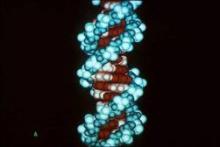WASHINGTON – The high trisomy 21 detection rate is among the selling points of noninvasive prenatal testing using cell-free DNA screening, though the test detects only a small number of abnormalities, Dr. Mary Norton said at the International Conference on Prenatal Diagnosis and Therapy.
During a symposium on introducing cfDNA screening into routine prenatal care, Dr. Norton, professor of obstetrics and gynecology at the University of California, San Francisco, said physicians are debating not only whether the cfDNA test should be used to screen low- versus high-risk women, but also whether cfDNA screening is appropriate as a primary screen for all pregnant women.
The use of noninvasive prenatal testing (NIPT) is growing in popularity, but its usefulness is narrow, focusing on three chromosomal abnormalities (trisomy 13, 21, and 18), while traditional diagnostic tests provide a broad screen for a wide array of abnormalities, she said.
One of the pros of using cfDNA as a primary screen is that “there’s no question” the detection rate for Down syndrome is better than with other methods, she said.
Other benefits include a lower false positive rate and a reduction in diagnostic tests.
In a prospective, international study published earlier this year that compared cfDNA testing to standard screening for trisomy 21, cfDNA testing identified trisomy 21 in all 38 women with the abnormality, compared to 30 of 38 with standard screening.
In the cfDNA group, the false positive rate was significantly lower (0.06% vs. 5.4%), and the positive predictive value was significantly higher (almost 81% vs. 3.4%) when compared with standard screening, according to Dr. Norton, who was the lead author of the study (N. Engl. J. Med. 2015;372:1589-97).
Another issue is positive predictive value, which is driven by prevalence of the abnormality screened, with lower prevalence corresponding to a lower PPV, she said. In a study of about 1,900 low-risk women whose mean maternal age was 30 years, cfDNA testing detected all cases of trisomy 21. The PPV for trisomy 21 was 45.5% compared with 4.2% with standard screening (N. Engl. J. Med. 2014;370:799-808).
But there are downsides to using the NIPT. For instance, cfDNA testing does not detect many other chromosome abnormalities.
In a study of more than 1.3 million women who had traditional prenatal screening between 2009 and 2012, about 17% of chromosome abnormalities identified were not detectable by current NIPT methods (Obset. Gynecol. 2014;124:979-86).
Other issues include test failure, which can occur because of a low fetal fraction (the amount of cfDNA in the maternal blood of fetal origin), as well as providers who offer cfDNA testing without a full understanding about the implications of positive results, Dr. Norton said.
In many communities, general ob.gyns. are confused about the meaning of the results, she said.
She pointed to a December 2014 investigative report on NIPT in the Boston Globe that said some women have terminated their pregnancies based on NIPT screening results without having a confirmatory diagnostic test.
And when using cfDNA screening, about 3% of samples do not provide a result, which can be associated with aneuploidy and cannot be ignored, Dr. Norton said.
The cfDNA testing is also expensive, Dr. Norton said. For patients who are young with a low risk for Down syndrome but higher risk for other abnormalities, it could be argued that a screening test should be “cheap and broad,” she said.
In the United States, there are many different ways serum and ultrasound screening is currently practiced, and cfDNA screening is being “integrated in very different ways in different settings,” she noted.
A recent American College of Obstetricians and Gynecologists and Society for Maternal-Fetal Medicine statement on cfDNA screening states that considering the performance of conventional screening methods, “the limitations of cell-free DNA screening performance, and the limited data on cost-effectiveness in the low-risk obstetric population, conventional screening methods remain the most appropriate choice for first line screening for most women in the general obstetric population.”
The statement also notes that while any patient, regardless of her risk, can choose cfDNA testing, she should understand the “limitations and benefits of this screening paradigm” in the context of alternative screening and diagnostic options.
The ACOG/SMFM opinion adds that the cfDNA technology for prenatal aneuploidy screening is rapidly changing, and that “any recommendations regarding its use in screening also will likely evolve quickly.”
Dr. Norton disclosed having received research support from Natera and Ariosa.


